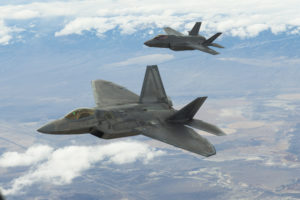 At the center of every good football team is a quarterback who can pick apart defenses before the ball is even hiked. He’s able to read his opponents, adapt, and communicate audibles on the fly. But what if your quarterback couldn’t speak?
At the center of every good football team is a quarterback who can pick apart defenses before the ball is even hiked. He’s able to read his opponents, adapt, and communicate audibles on the fly. But what if your quarterback couldn’t speak?
The F-22 and the F-35 are looked at as the quarterbacks for the U.S. Air Force. But there’s a problem with these quarterbacks of the sky, they can’t communicate with each other without breaking radio silence. The F-22 can’t transmit its sensitive data to any other aircraft except other F-22s. This limits the F-22 from passing along its “God’s Eye View” to other aircraft. Brian Everstine, Pentagon editor of Air Force Magazine, discusses the limitations and steps the U.S. Air Force is taking to harmonize all its communication systems.
The F-22 Raptor, the Air Force’s fifth generation air superiority fighter, has been described as a “game-changer” in current Middle East operations, using its advanced sensors to see huge swaths of territory and steer coalition aircraft around threats. As a de facto “quarterback” in the contested zone, it makes all other aircraft in the fight more effective.
That communication, though, is largely limited to radio calls. The F-22 can’t transmit the most sensitive data it collects to any aircraft besides other F-22s. While it can receive Link 16 data from other aircraft, it can’t pass along its “God’s-eye view” to other players in the force. Even the other fifth generation fighter, the F-35, can’t communicate with the F-22 except at the voice level.The situation wasn’t brought about by negligence. In developing the F-22—and later, the F-35—designers needed to preserve the jets’ stealth against rapidly evolving adversaries. Standard radio emissions would reveal their locations, which meant devising ways the low-observable fighters could talk to each other without giving away their position. Both jets have what are called “low probability of detection/interecept” communications gear to stay hidden. The F-35’s system—because it was developed 10 years after the F-22’s—takes a different approach.
As a result, Air Force combat communications can become a kind of Tower of Babel. While Raptors can receive over the Link 16 network—the standard across US and NATO aircraft—it can’t transmit over the system. Instead, it uses the F-22-only Intra-Flight Data Link (IFDL). F-35s can transmit on Link 16 to fourth gen jets and talk among themselves using the stealthy Multifunction Advanced Data Link (MADL), a capability the Air Force had planned to install on the F-22 but canceled because of cost about five years ago.
The Air Force’s goal is to harmonize all these systems so that everyone can talk among themselves—both by voice and machine-to-machine—without an enemy listening in or figuring out where those stealth jets are.
Fixing the situation is “part of the larger effort to figure out how we’re going to move away from having a bunch of Rube Goldberg gateways trying to connect things, to having a jump to the next generation of networks and radios and how they talk to each other,” Air Combat Command head Gen. James M. Holmes told Air Force Magazine in November. […]
The F-22’s inability to share data has been an issue afflicting USAF operations since the fleet became operational. Some have speculated that the lack of stealth data sharing kept the Raptor from participating in the 2011 air campaign in Libya.
The Air Force acknowledges the communications restrictions, and both F-22 and F-35 pilot training includes workarounds to allow the stealth jets to communicate with their nonstealthy stablemates.
Read more here.
E.J. Smith - Your Survival Guy
Latest posts by E.J. Smith - Your Survival Guy (see all)
- Yes, Money Can Buy You Happiness - April 23, 2024
- State Income Taxes and the 2024 NFL Draft Class - April 23, 2024
- This ARK is Sinking - April 23, 2024
- “That’s Why I Hired You,” They Tell Me - April 22, 2024
- The Silver Lining of Higher Interest Rates - April 22, 2024















